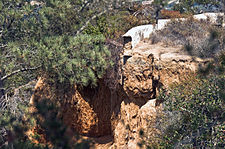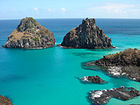- Coastal erosion
-
 Many stretches of the East Anglia, England coastline are prone to heavy levels of erosion, such as this, the collapsed section of cliffs at Hunstanton, Norfolk.
Many stretches of the East Anglia, England coastline are prone to heavy levels of erosion, such as this, the collapsed section of cliffs at Hunstanton, Norfolk.
Coastal erosion is the wearing away of land and the removal of beach or dune sediments by wave action, tidal currents, wave currents, or drainage (see also beach evolution). Waves, generated by storms, wind, or fast moving motor craft, cause coastal erosion, which may take the form of long-term losses of sediment and rocks, or merely the temporary redistribution of coastal sediments; erosion in one location may result in accretion nearby. The study of erosion and sediment redistribution is called 'coastal morphodynamics'. It may be caused by hydraulic action, abrasion, impact and corrosion.
On non-rocky coasts, coastal erosion results in dramatic (or non-dramatic) rock formations in areas where the coastline contains rock layers or fracture zones with varying resistance to erosion. Softer areas become eroded much faster than harder ones, which typically result in landforms such as tunnels, bridges, columns, and pillars.
Contents
Examples
An example of coastline erosion is in north Wales where over years of the sea beating at the cliffs the houses on top have begun collapsing into the sea. With some of them you can even see inside as the entire backs of some of the houses have come off and have been launched over the clifftop that has been torn through by the ferocious sea.
Dunwich, the capital of the English medieval wool trade, disappeared over the period of a few centuries due to redistribution of sediment by waves. Human interference can also increase coastal erosion: Hallsands in Devon, England, was a coastal village that washed away overnight, an event possibly exacerbated by dredging of shingle in the bay in front of it.
The California coast, which has soft cliffs of sedimentary rock and is heavily populated, regularly has incidents of housing damage as cliffs erode. Damage in Pacifica is shown at left. Devil's Slide, Santa Barbara and Malibu are regularly affected.
The Holderness coastline on the east coast of England, just north of the Humber Estuary, is the fastest eroding coastline in Europe due to its soft clay cliffs and powerful waves. Groynes and other artificial measures to keep it under control has only accelerated the process further down the coast, because longshore drift starves the beaches of sand, leaving them more exposed. The White Cliffs of Dover have also been affected.
Wave action
Hydraulic action
Hydraulic action occurs when waves striking a cliff face compress air in cracks on the cliff face. This exerts pressure on the surrounding rock, and can progressively splinter and remove pieces. Over time, the cracks can grow, sometimes forming a cave. The splinters fall to the sea bed where they are subjected to further wave action.
Attrition
Attrition occurs when waves causes loose pieces of rock debris (scree) to collide with each other, grinding and chipping each other, progressively becoming smaller, smoother and rounder. Scree also collides with the base of the cliff face, chipping small pieces of rock from the cliff or have a corrasion (abrasion) effect, similar to sandpapering.
Corrasion and corrosion
Corrasion (abrasion) occurs when waves break on cliff faces and slowly erode it. As the sea pounds cliff faces it also uses the scree from other wave actions to batter and break off pieces of rock from higher up the cliff face which can be used for this same wave action and attrition.
Corrosion or solution/chemical weathering occurs when the sea's pH (anything below pH 7.0) corrodes rocks on a cliff face. Limestone cliff faces, which have a high pH, are particularly affected in this way. Wave action also increases the rate of reaction by removing the reacted material.
Factors that influence erosion rates
Primary factors
The ability of waves to cause erosion of the cliff face depends on many factors.
The hardness or ‘erodibility’ of sea-facing rocks is controlled by the rock strength and the presence of fissures, fractures, and beds of non-cohesive materials such as silt and fine sand.
The rate at which cliff fall debris is removed from the foreshore depends on the power of the waves crossing the beach. This energy must reach a critical level to remove material from the debris lobe. Debris lobes can be very persistent and can take many years to completely disappear.
Beaches dissipate wave energy on the foreshore and provide a measure of protection to the adjoining land.
The stability of the foreshore, or its resistance to lowering. Once stable, the foreshore should widen and become more effective at dissipating the wave energy, so that fewer and less powerful waves reach beyond it. The provision of updrift material coming onto the foreshore beneath the cliff helps ensure a stable beach.
The adjacent bathymetry, or configuration of the seafloor, controls the wave energy arriving at the coast, and can have an important influence on the rate of cliff erosion. Shoals and bars offer protection from wave erosion by causing storm waves to break and dissipate their energy before reaching the shore. Given the dynamic nature of the seafloor, changes in the location of shoals and bars may cause the locus of beach or cliff erosion to change position along the shore.[1]
- Coastal Erosion
-
Pacifica, California coast after major storms in 1997 destroyed the houses shown above.
-
Beach erosion at Cabrillo National Monument, California.
-
Large-scale coastal erosion at Torrey Pines State Reserve, California.
-
Coastal erosion at Torrey Pines State Reserve, California, resulted in the necessary relocation of a scenic overlook.
Secondary factors
- Weathering and transport slope processes
- Slope hydrology
- Vegetation
- Cliff foot erosion
- Cliff foot sediment accumulation
- Resistance of cliff foot sediment to attrition and transport
Tertiary factors
- Resource extraction
- Coastal management
See also
- Beach nourishment
- Bioerosion
- Blowhole
- Coastal and Estuarine Research Federation (CERF)
- Coastal sediment supply
- Coastal and oceanic landforms
- Coastal management
- Deposition (sediment)
- Erosion
- Longshore Drift
- Marine terrace
- Modern recession of beaches
- Natural arch
- Submersion
- Sand dune stabilization
- Coastal Development Hazards
External links
- Sustainable coastal erosion management in Europe
- Coastal Erosion Information from the Coastal Ocean Institute, Woods Hole Oceanographic Institution
- Environment Agency guide to coastal erosion
- Wave Erosion
- Time-lapse movie of beach erosion in Australia
- Examine an example of wave erosion
- Erosion & Flooding in the Parish of Easington
- Some interesting teaching resources
- Examples of coastal landforms
- US Economic Costs of Coastal Erosion & Inundation NOAA Economics
- British Geological Survey coastal erosion and landslides case studies
Images:
References
- ^ Oldale, Robert N.. "Coastal Erosion on Cape Cod: Some Questions and Answers". U.S. Geological Survey. http://woodshole.er.usgs.gov/staffpages/boldale/capecod/index.html. Retrieved 2009-09-11.
Categories:- Geomorphology
- Coastal geography
- Coastal engineering
- Coastal construction
- Coastal erosion
Wikimedia Foundation. 2010.






